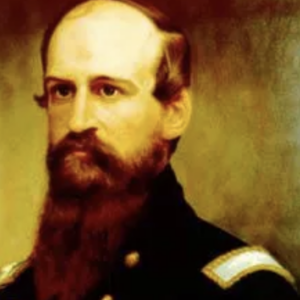Everyone is too busy these days. We hardly stop to smell the roses, much less appreciate the richness of the New Hampshire history that surrounds us. Civil War history now sets off firestorms of debate, protest, and even destruction in other parts of the country. We do not need those troubles, but we do need to do a better job of recognizing our heroes.
One such hero, whose picture proudly hangs in the New Hampshire State House, is Col. Edward Ephraim Cross (April 22, 1832 – July 3, 1863). He was both a prolific newspaperman and a remarkable officer. Cross served in the Union Army during the American Civil War, and he was killed in the Battle of Gettysburg.
The story of his death haunts me. If you look closely at his painted picture, which is located to the left just past the Hall of Flags on the first floor of the State House, you can imagine him on that hot July day in the fields of Pennsylvania. Cross was known for wearing a red bandanna into battle rather than the traditional officer’s hat. Although that clearly made him a target for Confederate sharpshooters, it was not what led to his death. In fact, the day he received his mortal wound, he was wearing a black bandanna.
Legend holds that Union Maj. Gen. Winfield S. Hancock noticed that his bandanna was black rather than red. He questioned Cross on the subject and was told the colonel had foreseen his death that day and that black was more fitting. That morning, he had also seen some ambulances behind the lines and was heard to remark, “We shan’t want any of your death wagons today.” Goosebumps.
Cross was born in Lancaster, N.H. He attended the common school and academy there. He was educated, adventurous, colorful, and a true Granite Stater. He is worth knowing about. When he was 15 years old, he began writing as a printer for a local newspaper, The Coös Democrat. He later worked as a printer for The Cincinnati Times. He was that paper’s Washington correspondent during two sessions of Congress and also wrote articles for other newspapers, including The New York Herald.
On July 27, 1858, he left Cincinnati for Tubac, Arizona Territory, and Cross established the territory’s first newspaper, the Weekly Arizonian. There, he also served at times in the United States Army as a scout during expeditions in Apache country. All of this rich history comes alive when you look at Colonel Cross’ picture with informed intent, which brings us back to the present day.
There is a growing cultural movement to purge history of anything that makes our modern minds uncomfortable. New York’s City Council, having already removed the statue of Thomas Jefferson from City Hall, has recently been looking at taking down all statuary of George Washington. While there is no doubt there are tragic and painful aspects of our history, we really do ourselves and the past a disservice by trying to completely melt it away. We need to be taking a closer look at the complicated stories of our Colonel Crosses. We need to remember the people who lived and died to create the country and the freedoms we all enjoy today.
As we look back at November and Veterans Day 2023, let us commit to remembering our veterans all year long. Colonel Cross led the 5th New Hampshire Volunteer Infantry. “The Fighting Fifth” had the unfortunate distinction of having sustained the greatest total loss in battles of any infantry or cavalry regiment in the Union Army, with a total of 295 killed and 756 wounded, for a total of 1,051 men. Throughout the Civil War, at least 32,486 Granite State soldiers fought to end slavery and preserve the Union. We lost at least 4,840 of these brave lives to the conflict. Cross is one man among many that we should honor and remember. We should know his name and visit his picture in our people’s house.
To reference another famous portrait, in “The Picture of Dorian Gray,” Oscar Wilde wrote, “Nowadays people know the price of everything and the value of nothing.” Wilde’s point holds true today just as it did during the Victorian Era, and I challenge you to remember the value of freedom.




